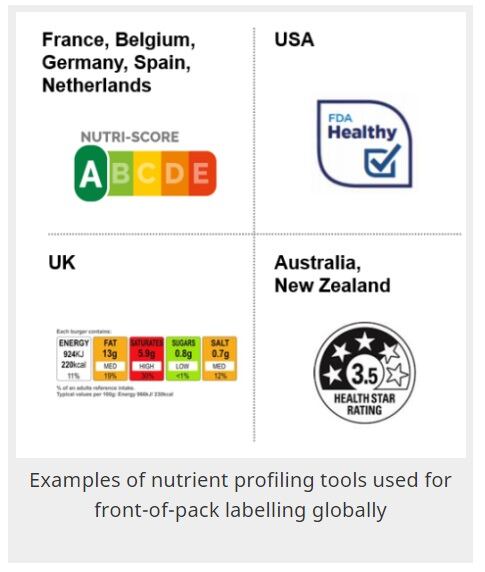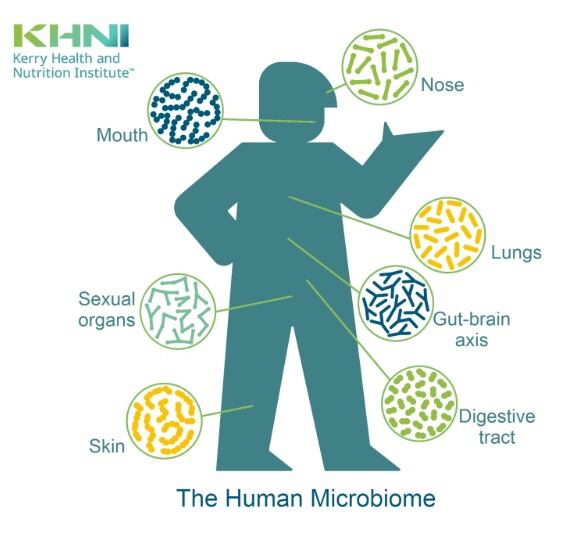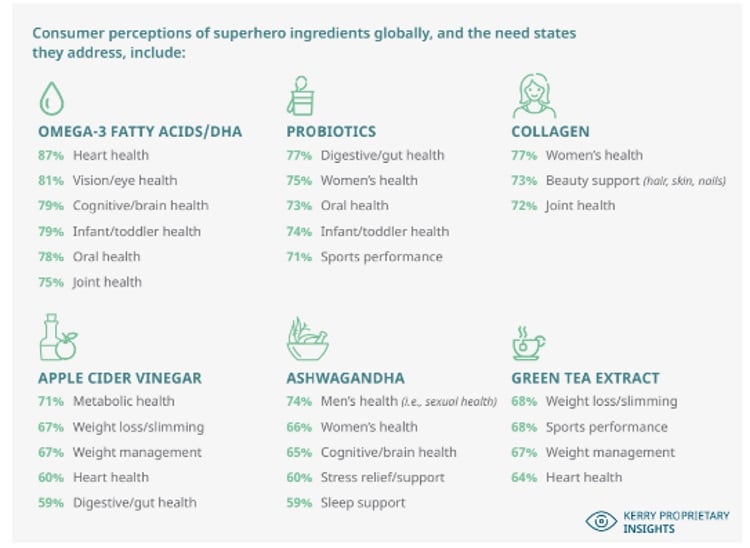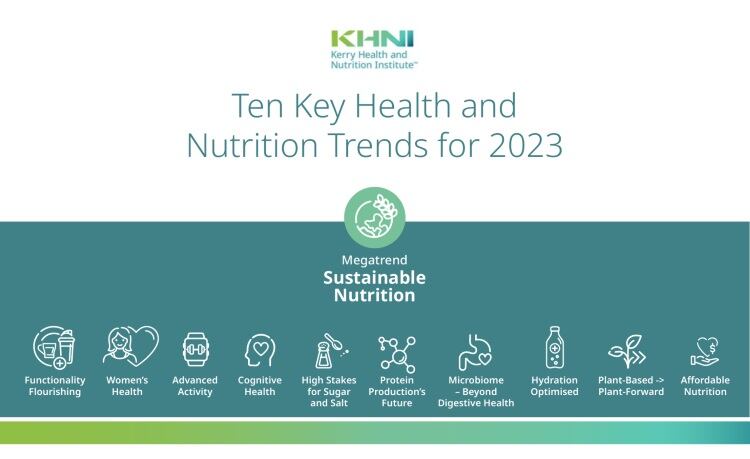Today’s consumers are proactively managing their physical and mental wellbeing, and are on the lookout for better-for-you products that not only good for themselves, but also for the planet. Underpinning this in these belt-tightening times is the need for affordable nutrition.
“Sustainability continues to be the leading driver in food and beverage innovation, as consumers become increasingly focused on health and affordability in their nutritional spend,” said Nathan Pratt, senior nutrition scientist at Kerry.
Leveraging developments in research, technology and product development, KHNI’s global network of researchers analysed the trends expected to drive consumer behaviour this year and the opportunities they present for product developers.
“The Kerry Health and Nutrition Institute’s research finds 2023 will see long-standing trends of health and sustainability take more personalised approach to specific consumer groups and need-states,” added Pratt.
“Nutritional innovation is increasingly enabling consumers to proactively manage their physical and mental health through functional beverages, sex-specific nutrition and probiotics for more than digestive health.
“We are also seeing consumers placing increased importance on the nutritional density of their foods, as they seek affordable yet healthy alternatives in today’s macroenvironment.
“The industry must consider all of these trends in the context of feeding a growing global population – a task to which food science and technology will be critically important in the coming year and beyond.”
Top 10 trends for 2023
Crackdown on sugar and salt

Changes in nutrition and labelling legislation are becoming more widespread, and consumers are becoming more health conscience.
Front-of-pack signposting is increasing to make healthier choices simpler but is also driving the increasing need for innovative technology to help manufacturers create healthier, more sustainable products that deliver on taste and experience.
Takeaway:
National governments are becoming less forgiving to the food industry, propelling efforts to nutritionally improve foods and beverages.
Consumers are becoming more health conscious, resulting in an increase in front of pack signposting.
Differing front of pack labelling and marketing restrictions across countries will make it more difficult for companies to sell products across several countries.
Decreasing nutrients of concern like sodium, sugar, and saturated fat while maintaining taste and shelf life will be the major challenges introduced by these global initiatives.

Keeping costs in check
With inflation at 40-year high, affordable nutrition has never been more critical.
According to Kerry’s experts, food innovation is not only about premium novel ingredients, but must also focus on how producers can make the food system more economically sustainable by maximising the nutritional density and affordability of foods and snacks.
Takeaway:
Taste and sensory knowledge are a hidden opportunity – a broad knowledge of masking different protein types can allow flexibility in raw material sourcing as cost fluctuates.
Whole grains, egg, dairy, fruits and vegetables are nutritionally dense and can be the best sources of nutrition per dollar. Beans are a great example of an inexpensive food that provides fibre, protein, minerals and calories.
Plant-based to plant-forward
Consumers are increasingly looking beyond meat mimicry to plant-forward products as they challenge the heavily processed nature of plant proteins.
Plant-forward innovations that offer servings of fruits, vegetables or whole grains can help bridge gaps in the consumer’s day-to-day diet, while differentiating themselves in the plant-based market.
Protein production’s future
It will be nearly impossible to feed the planet’s population growth using our current systems of food production – with an expected global popular of 10 billion by 2050.
Food science and technology will be critically important to innovate alternative means of producing the protein required to feed the planet.
Women’s health
A broad scope of clinical research is increasingly addressing women’s health issues though nutrition, ranging from digestive, heart and cognitive health to specific needs such as fertility, breastfeeding and menopause.
Although women are at higher risk of nutrient deficiencies than men at certain stages – leading to chronic diseases such as cardiovascular disease, strokes and cancer – much of the research on these diseases to date has been conducted on men.
Takeaway:
Expect to see this trend accelerate in the near future with increased clinical research into female-specific conditions and the growing capabilities of precision nutrition.
Certain plant-based botanicals have potential to support female specific conditions – for example, licorice root extract has a similar structure to estrogen and is popular in dietary supplements to alleviate menopausal symptoms. The evidence base for these botanicals is growing.
Beyond digestive health

Microbes extend far beyond the gut or digestive tract, and microbiologists are identifying more bacteria with interesting properties.
The microbiome has been also linked to reproductive and cardiometabolic health, alongside immunity. As advances in molecular research continue, it is of tremendous importance that associated probiotic products deliver the benefits they are claimed to.
Advanced activity
Joint health and cardiovascular health are not just for healthy ageing anymore – expect to see more products with these benefits targeting all active age groups.
Gym-goers are looking to enhance the function of their joints, heart and vascular system to allow more mobility, more effective workouts and reduce risk of injury.
Reducing inflammation is a key way ingredients can help support these areas of health.
Cognitive health
There is an increased focus on mental wellbeing post-Covid. A growing body of science on the role of ingredients such as adaptogens and nootropics in brain health is seeing cognitive health carve a strong foothold in the F&B space.
Expect to see this trend fragment in the future – we’ve moved beyond ‘energy’and having one product fit that need – typically coffee – into very specific aspects of cognition like focus, attention, short-term or working memory and so forth.
Think about dayparts when choosing a type of cognitive health benefit, for example, focus for morning, stress for afternoon, relaxation for evening.
Hydration optimised
Hydration is moving beyond plain water as consumers look for more exciting options such as sparkling water or electrolyte powers.
There is also a move away from sweetness, and sparkling waters and low-sweetness options are being chosen more commonly by consumers looking to hydrate and manage weight.
Functionality flourishing

Functional beverages, too, are leading an industry-wide boom in products aimed to help consumers proactively manage their health.
Takeaway:
Consumers are focusing more on short-term need states – beauty, immune support, digestive health, energy and weight management are among the top 5 desired health benefits globally.
Balancing consumer perception with science is important – ingredients should resonate with consumer beliefs about health but also be shown to have a demonstrated health benefit in scientific studies.
Specificity is important – consumers are looking for specific health benefits from specific types of products at specific times of the day, and these vary by age group. It’s essential to understand the specific consumer target when developing products.





